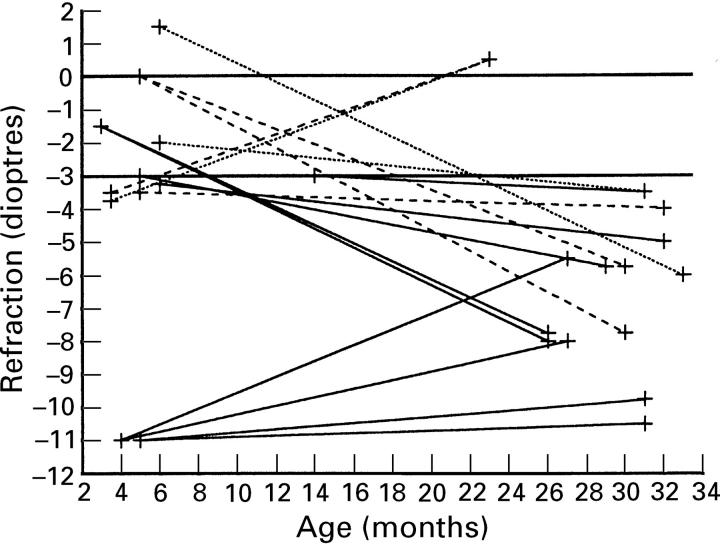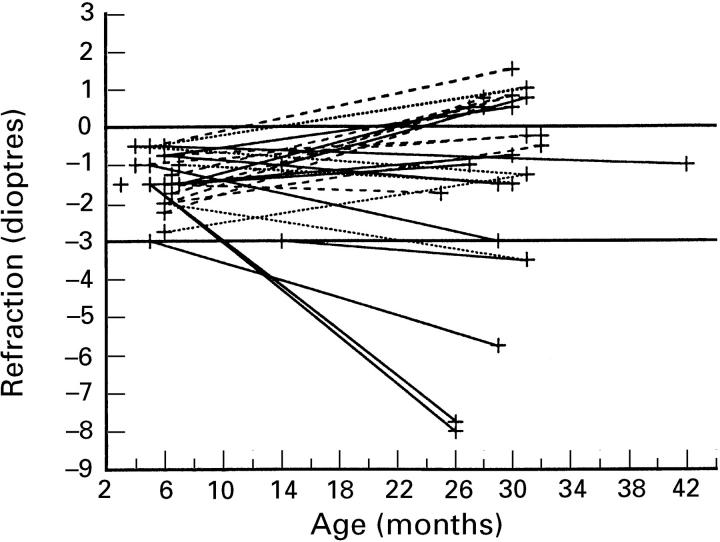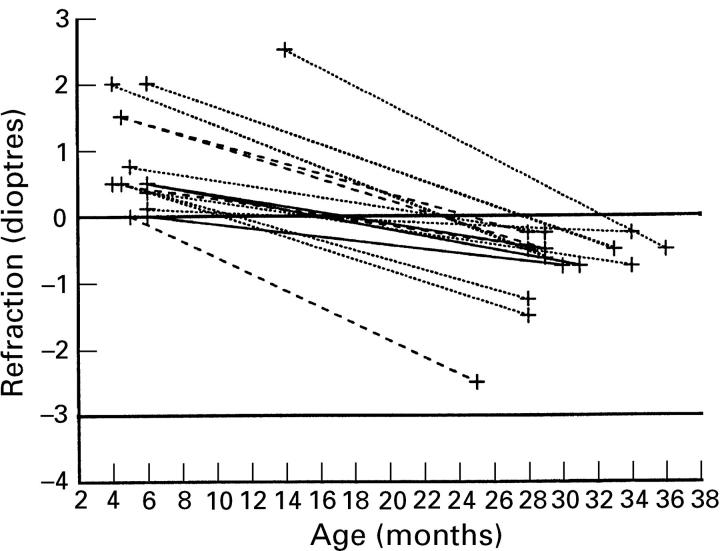Abstract
BACKGROUND—Numerous studies have reported an increased risk of refractive errors in prematurely born infants, but only few have been long term and strictly population based. METHODS—A 3.5 year ophthalmological long term follow up of 248 preterm infants was performed. The infants had been included in a previous epidemiological study of retinopathy of prematurity (ROP) (birth weight ⩽ 1500 grams). The incidence of refractive errors and development of refraction were studied, based on retinoscopies at 6 and 30 months of corrected age. RESULTS—The overall incidence of myopia was 8% at 6 months, of which 35% was transient, and 10% at 30 months. Of the cryotreated infants, 30-40% were myopic at both retinoscopies. The incidence of astigmatism was 52% at 6 months and 26% at 30 months. Astigmatism was associated with ROP, but not with cryotreated ROP itself. Astigmatism "against the rule" was commoner than astigmatism "with the rule". Anisometropia occurred in 6.5% of the infants at 6 months and in 8.4% at 30 months. The incidence of anisometropia was higher in eyes with ROP, particularly in cryotreated eyes, which tended to have high and persistent anisometropia. CONCLUSION—The risk of refractive errors is higher in preterm infants than in infants born at term, and also prematurely born infants without ROP do run an increased risk of having myopia and anisometropia. We recommend follow up examinations with retinoscopy for all infants included in screening programmes for ROP. Keywords: prematurity; prospective study; retinopathy of prematurity; refraction
Full Text
The Full Text of this article is available as a PDF (137.3 KB).
Figure 1 .
Course of "high" myopia (<−3 D) in 11 infants on first (eight eyes) or second (eight eyes) retinoscopies. Dotted line=eyes without ROP, broken line=eyes with untreated ROP, solid line=eyes with cryotreated ROP.
Figure 2 .
Course of "slight" myopia (⩾−3 D) in 16 infants (29 eyes) on first retinoscopy. Dotted line=eyes without ROP, broken line=eyes with untreated ROP, solid line=eyes with cryotreated ROP.
Figure 3 .
Course of refraction in 10 infants (18 eyes) who had developed "slight" myopia (⩾3 D) on second retinoscopy. Dotted line=eyes without ROP, broken line=eyes with untreated ROP, solid line=eyes with cryotreated ROP.
Selected References
These references are in PubMed. This may not be the complete list of references from this article.
- Abrahamsson M., Fabian G., Sjöstrand J. A longitudinal study of a population based sample of astigmatic children. II. The changeability of anisometropia. Acta Ophthalmol (Copenh) 1990 Aug;68(4):435–440. doi: 10.1111/j.1755-3768.1990.tb01672.x. [DOI] [PubMed] [Google Scholar]
- Abrahamsson M., Fabian G., Sjöstrand J. Changes in astigmatism between the ages of 1 and 4 years: a longitudinal study. Br J Ophthalmol. 1988 Feb;72(2):145–149. doi: 10.1136/bjo.72.2.145. [DOI] [PMC free article] [PubMed] [Google Scholar]
- Atkinson J., Braddick O., French J. Infant astigmatism: its disappearance with age. Vision Res. 1980;20(11):891–893. doi: 10.1016/0042-6989(80)90070-x. [DOI] [PubMed] [Google Scholar]
- BIRGE H. L. Myopia caused by prematurity. Am J Ophthalmol. 1956 Feb;41(2):292–298. doi: 10.1016/0002-9394(56)92026-8. [DOI] [PubMed] [Google Scholar]
- Cats B. P., Tan K. E. Prematures with and without regressed retinopathy of prematurity: comparison of long-term (6-10 years) ophthalmological morbidity. J Pediatr Ophthalmol Strabismus. 1989 Nov-Dec;26(6):271–275. doi: 10.3928/0191-3913-19891101-05. [DOI] [PubMed] [Google Scholar]
- Darlow B. A. Incidence of retinopathy of prematurity in New Zealand. Arch Dis Child. 1988 Sep;63(9):1083–1086. doi: 10.1136/adc.63.9.1083. [DOI] [PMC free article] [PubMed] [Google Scholar]
- Dobson V., Fulton A. B., Sebris S. L. Cycloplegic refractions of infants and young children: the axis of astigmatism. Invest Ophthalmol Vis Sci. 1984 Jan;25(1):83–87. [PubMed] [Google Scholar]
- Fledelius H. C. Myopia of prematurity, clinical patterns. A follow-up of Danish children now aged 3-9 years. Acta Ophthalmol Scand. 1995 Oct;73(5):402–406. doi: 10.1111/j.1600-0420.1995.tb00297.x. [DOI] [PubMed] [Google Scholar]
- Fledelius H. C. Pre-term delivery and subsequent ocular development. A 7-10 year follow-up of children screened 1982-84 for ROP. 3) Refraction. Myopia of prematurity. Acta Ophthalmol Scand. 1996 Jun;74(3):297–300. doi: 10.1111/j.1600-0420.1996.tb00096.x. [DOI] [PubMed] [Google Scholar]
- Gallo J. E., Lennerstrand G. A population-based study of ocular abnormalities in premature children aged 5 to 10 years. Am J Ophthalmol. 1991 May 15;111(5):539–547. doi: 10.1016/s0002-9394(14)73695-5. [DOI] [PubMed] [Google Scholar]
- Gwiazda J., Scheiman M., Mohindra I., Held R. Astigmatism in children: changes in axis and amount from birth to six years. Invest Ophthalmol Vis Sci. 1984 Jan;25(1):88–92. [PubMed] [Google Scholar]
- Holmström G., el Azazi M., Jacobson L., Lennerstrand G. A population based, prospective study of the development of ROP in prematurely born children in the Stockholm area of Sweden. Br J Ophthalmol. 1993 Jul;77(7):417–423. doi: 10.1136/bjo.77.7.417. [DOI] [PMC free article] [PubMed] [Google Scholar]
- Ingram R. M., Barr A. Changes in refraction between the ages of 1 and 3 1/2 years. Br J Ophthalmol. 1979 May;63(5):339–342. doi: 10.1136/bjo.63.5.339. [DOI] [PMC free article] [PubMed] [Google Scholar]
- Kalina R. E. Ophthalmic examination of children of low birth weight. Am J Ophthalmol. 1969 Jan;67(1):134–136. doi: 10.1016/0002-9394(69)90018-x. [DOI] [PubMed] [Google Scholar]
- Keith C. G., Kitchen W. H. Ocular morbidity in infants of very low birth weight. Br J Ophthalmol. 1983 May;67(5):302–305. doi: 10.1136/bjo.67.5.302. [DOI] [PMC free article] [PubMed] [Google Scholar]
- Koole F. D., Bax P. P., Samsom J. F., van der Lei J. Ocular examination in nine-month-old infants with very low birthweights. Ophthalmic Paediatr Genet. 1990 Jun;11(2):89–94. doi: 10.3109/13816819009012952. [DOI] [PubMed] [Google Scholar]
- Kushner B. J. Strabismus and amblyopia associated with regressed retinopathy of prematurity. Arch Ophthalmol. 1982 Feb;100(2):256–261. doi: 10.1001/archopht.1982.01030030258004. [DOI] [PubMed] [Google Scholar]
- Köhler L., Stigmar G. Vision screening of four-year-old children. Acta Paediatr Scand. 1973 Jan;62(1):17–27. doi: 10.1111/j.1651-2227.1973.tb08060.x. [DOI] [PubMed] [Google Scholar]
- Laws D., Shaw D. E., Robinson J., Jones H. S., Ng Y. K., Fielder A. R. Retinopathy of prematurity: a prospective study. Review at six months. Eye (Lond) 1992;6(Pt 5):477–483. doi: 10.1038/eye.1992.101. [DOI] [PubMed] [Google Scholar]
- Lue C. L., Hansen R. M., Reisner D. S., Findl O., Petersen R. A., Fulton A. B. The course of myopia in children with mild retinopathy of prematurity. Vision Res. 1995 May;35(9):1329–1335. doi: 10.1016/0042-6989(94)00227-d. [DOI] [PubMed] [Google Scholar]
- Nissenkorn I., Yassur Y., Mashkowski D., Sherf I., Ben-Sira I. Myopia in premature babies with and without retinopathy of prematurity. Br J Ophthalmol. 1983 Mar;67(3):170–173. doi: 10.1136/bjo.67.3.170. [DOI] [PMC free article] [PubMed] [Google Scholar]
- Page J. M., Schneeweiss S., Whyte H. E., Harvey P. Ocular sequelae in premature infants. Pediatrics. 1993 Dec;92(6):787–790. [PubMed] [Google Scholar]
- Pennefather P. M., Clarke M. P., Strong N. P., Cottrell D. G., Fritz S., Tin W. Ocular outcome in children born before 32 weeks gestation. Eye (Lond) 1995;9(Pt 6 SU):26–30. [PubMed] [Google Scholar]
- Pennefather P. M., Tin W., Strong N. P., Clarke M. P., Dutton J., Cottrell D. G. Refractive errors in children born before 32 weeks gestation. Eye (Lond) 1997;11(Pt 5):736–743. doi: 10.1038/eye.1997.188. [DOI] [PubMed] [Google Scholar]
- Quinn G. E., Dobson V., Barr C. C., Davis B. R., Flynn J. T., Palmer E. A., Robertson J., Trese M. T. Visual acuity in infants after vitrectomy for severe retinopathy of prematurity. Ophthalmology. 1991 Jan;98(1):5–13. doi: 10.1016/s0161-6420(91)32343-1. [DOI] [PubMed] [Google Scholar]
- Quinn G. E., Dobson V., Repka M. X., Reynolds J., Kivlin J., Davis B., Buckley E., Flynn J. T., Palmer E. A. Development of myopia in infants with birth weights less than 1251 grams. The Cryotherapy for Retinopathy of Prematurity Cooperative Group. Ophthalmology. 1992 Mar;99(3):329–340. doi: 10.1016/s0161-6420(92)31968-2. [DOI] [PubMed] [Google Scholar]
- Robinson R., O'Keefe M. Follow-up study on premature infants with and without retinopathy of prematurity. Br J Ophthalmol. 1993 Feb;77(2):91–94. doi: 10.1136/bjo.77.2.91. [DOI] [PMC free article] [PubMed] [Google Scholar]
- Shapiro A., Yanko L., Nawratzki I., Merin S. Refractive power of premature children at infancy and early childhood. Am J Ophthalmol. 1980 Aug;90(2):234–238. doi: 10.1016/s0002-9394(14)74860-3. [DOI] [PubMed] [Google Scholar]
- Snir M., Nissenkorn I., Sherf I., Cohen S., Ben Sira I. Visual acuity, strabismus, and amblyopia in premature babies with and without retinopathy of prematurity. Ann Ophthalmol. 1988 Jul;20(7):256–258. [PubMed] [Google Scholar]
- Tuppurainen K., Herrgård E., Martikainen A., Mäntyjärvi M. Ocular findings in prematurely born children at 5 years of age. Graefes Arch Clin Exp Ophthalmol. 1993 May;231(5):261–266. doi: 10.1007/BF00919102. [DOI] [PubMed] [Google Scholar]





